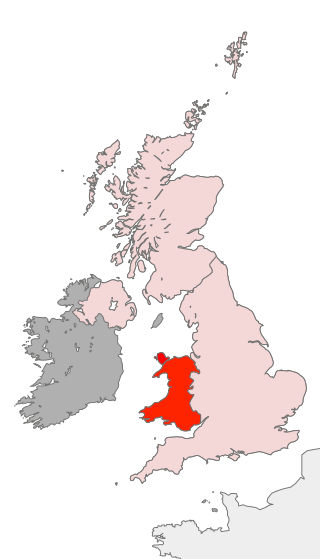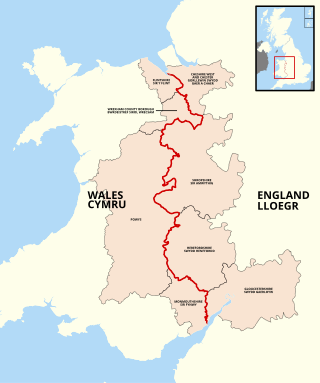
Powys is a county and preserved county in Wales. It borders Gwynedd, Denbighshire, and Wrexham to the north; the English ceremonial counties of Shropshire and Herefordshire to the east; Monmouthshire, Blaenau Gwent, Merthyr Tydfil, Caerphilly, Rhondda Cynon Taf, and Neath Port Talbot to the south; and Carmarthenshire and Ceredigion to the west. The largest settlement is Newtown, and the administrative centre is Llandrindod Wells.

Until 1974, Brecknockshire, also formerly known as the County of Brecknock, Breconshire, or the County of Brecon, was an administrative county in the south of Wales, later classed as one of the thirteen historic counties of Wales. Named after its county town of Brecon, the county was mountainous and primarily rural.

The preserved counties of Wales are the eight current areas used in Wales for the ceremonial purposes of lieutenancy and shrievalty. They are based on the counties which were used for local government and other purposes between 1974 and 1996. Each comprises one or more of the 22 single-tier principal areas which are used for administrative purposes.

Presteigne is a town and community in Radnorshire, Powys, Wales on the south bank of the River Lugg. Formerly the county town of the historic county of Radnorshire, the town has, in common with several other towns close to the Wales-England border, assumed the motto, "Gateway to Wales". The border wraps around three sides of the town. Nearby towns are Kington, Herefordshire to the south and Knighton to the north, and surrounding villages include Norton and Stapleton. The town falls within the Diocese of Hereford. The community has a population of 2,710; the built-up area had a population of 2,056.

Builth Wells is a market town and community in the county of Powys and historic county of Brecknockshire (Breconshire), mid Wales, lying at the confluence of rivers Wye and Irfon, in the Welsh part of the Wye Valley. In 2011 it had a population of 2,568.

South Wales is a loosely defined region of Wales bordered by England to the east and mid Wales to the north. Generally considered to include the historic counties of Glamorgan and Monmouthshire, south Wales extends westwards to include Carmarthenshire and Pembrokeshire. In the western extent, from Swansea westwards, local people would probably recognise that they lived in both south Wales and west Wales. The Brecon Beacons National Park covers about a third of south Wales, containing Pen y Fan, the highest British mountain south of Cadair Idris in Snowdonia.

The University of Wales, Newport, was a university based in Newport, South Wales, before the merger that formed the University of South Wales in April 2013. The university had two campuses in Newport, Caerleon on the northern outskirts of the city, which was subsequently closed during July 2016, and a £35 million campus on the east bank of the River Usk in Newport city centre which opened in 2011. In 2012 the university was ranked 111th out of 120 UK universities in the Guardian League Table for university rankings, 105th out of 116 in The Complete University Guide and 104th out of 116 UK universities in the Times Good University Guide.

A Scout County is an administrative division within The Scout Association of the United Kingdom. There are currently 115 Counties and Areas in the United Kingdom. These bodies are responsible for providing programmes and support for their member Scout Districts.

Foxlease is a training and activity centre of Girlguiding near Lyndhurst, Hampshire, UK. The Foxlease estate has been owned and managed by the Guides since 1922. The estate is 65 acres (260,000 m2) and the main house is known as The Princess Mary House, in honour of her marriage. Foxlease hosted the Guides' Third International Conference, the Sixth World Conference and also the first World Camp.
The history of local government in Wales in a recognisably modern form emerged during the late 19th century. Administrative counties and county boroughs were first established in Wales in 1889. Urban and rural districts were formed in 1894. These were replaced in 1974 by a two-tier authority system across the country comprising eight counties and, within them, thirty-seven districts. This system was itself replaced by the introduction of 22 single-tier authorities in 1996.

Broneirion is a Victorian house and grounds on the hillside across the River Severn from the village of Llandinam. It was built by Welsh industrialist David Davies. It has been used as a training centre for Girl Guides since 1946 and has been owned since 1992 by Girlguiding Cymru. In 2022, they announced the mansion had been put on sale and the centre would be closed.

Girlguiding Scotland is part of the worldwide Guiding movement. It is the country's largest voluntary organisation for girls and young women with 61,375 members in 3,500 units throughout Scotland.

Scouting in Wales provides an overview of Scouting activities in Wales. Scout troops have existed in the country since 1908 with the largest number of Scouts and volunteer leaders today linked to the Scout Association of the United Kingdom. This is done through ScoutsCymru, the Welsh Scout Council who split the region further into four regions and a total of 12 Scout Areas. In addition to the Scout Association, there are also traditional Scouting groups belonging to the Baden-Powell Scouts' Association and a number of Scouting clubs within Universities which are affiliated to the Student Scout and Guide Organisation.

The England–Wales border, sometimes referred to as the Wales–England border or the Anglo-Welsh border, runs for 160 miles (260 km) from the Dee estuary, in the north, to the Severn estuary in the south, separating England and Wales.

The following outline is provided as an overview of and topical guide to Wales:
The Welsh National Water Development Authority (WNWDA) and later the Welsh Water Authority was one of ten regional water authorities set up in the UK and came into existence on 6 August 1973 with its headquarters in Brecon. by virtue of the Water Act 1973 It took over the sewerage and sewage disposal responsibilities of the local authorities within its area, the roles and responsibilities of the six existing River Authorities in Wales and most of the water supply undertakings. The authority was dissolved in 1989 as part of the privatisation of the water industry.

Gwlad is a centre-right Welsh nationalist and pro-independence political party. Its current leader is Gwyn Wigley Evans.
The Register of Landscapes of Historic Interest in Wales is a non-statutory heritage register of 58 landscapes of outstanding or special historic interest published in two volumes. It was produced by a partnership between Cadw, the Countryside Council for Wales, and the International Council on Monuments and Sites working in collaboration with the Welsh Archaeological Trusts and several other organisations with the intention of aiding in the protection and conservation of the most important and significant historic landscape areas in Wales.
Rosa Ward OBE, JP was a pioneer of the Girl Guide movement. She was chair of the Guide International Service from 1942 to 1954. She was a recipient of the Silver Fish Award, the movement's highest adult honour.
















